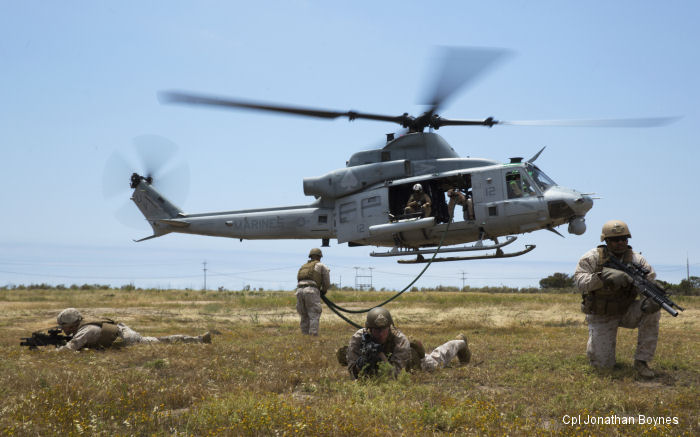
US Marine Corps, May 12, 2016 - MARINE CORPS BASE CAMP PENDLETON, Calif. by Cpl Jonathan Boynes – Succeeding in environments where others have failed is both a point of pride for the Marine Corps, but also a well-known staple of the service which has helped to maintain its relevancy from inception up to the modern-day battlefields of the 21st century.
Training to keep pace with the demanding tempo of today’s conflicts is no easy task and the need for a versatile, effective force is as great as ever. Fortunately, the instructors of 1st Air Naval Gunfire Liaison Company, I Marine Expeditionary Force, make it a point to pass helicopter rope suspension techniques to their students.
Fast roping was the focus of their training on May 9, 2016, and it all started at the base of a rappel tower on Camp Pendleton. It was here that the instructors began guiding dozens of students from across I MEF through techniques which eventually would lead them to rappel from helicopters hovering nearly 40 feet off the ground later in the day.
Though HRST is a difficult and unique collection of skillsets to master, the payoff is well worth the effort invested into the training. It helps broaden the already expansive organic operational capabilities of the Marine Corps as well as showcasing the expeditionary nature of the force.
“HRST allows us to insert or extract from areas that normally would be inaccessible through regular means of transportation,” said Sgt. Kurtis Gagnon, a training chief with 1st ANGLICO. “This gives us a huge edge in a lot of different scenarios. We can insert directly onto objectives, it’s safer for us, and far more devastating for the enemy.”
To develop and maintain this advantage in combat, the Marine Corps trains dedicated and knowledgeable instructors ready to take on the challenge of teaching high-risk and in-depth techniques.
Marines also enhanced interoperability by training with British Royal Marine Commandos. This is important, because when Marines deploy they are often accompanied by partner nations.
ANGLICO must meet the needs of the Marine Corps through liaising with America’s allies and other friendly forces making it a unique asset.
“There is a lot of pressure on the instructors and I to provide students with the best training possible,” said Capt. Eric Vanhorn, a firepower control team leader, 1st ANGLICO. “I have to trust that the HRST school is maintaining the reputation that it has built by putting out properly trained HRST masters who are able to pass on what they have learned. I have yet to see failure.”
The Marine Corps’ training is time-tested and has been proven to work. Its instructors know this through experience and the world knows it through the battles they’ve won. HRST is only a
small sample of the Corps’ capabilities, but it’s an accurate testament to expeditionary spirit which permeates all that it does.
Training to keep pace with the demanding tempo of today’s conflicts is no easy task and the need for a versatile, effective force is as great as ever. Fortunately, the instructors of 1st Air Naval Gunfire Liaison Company, I Marine Expeditionary Force, make it a point to pass helicopter rope suspension techniques to their students.
Fast roping was the focus of their training on May 9, 2016, and it all started at the base of a rappel tower on Camp Pendleton. It was here that the instructors began guiding dozens of students from across I MEF through techniques which eventually would lead them to rappel from helicopters hovering nearly 40 feet off the ground later in the day.
Though HRST is a difficult and unique collection of skillsets to master, the payoff is well worth the effort invested into the training. It helps broaden the already expansive organic operational capabilities of the Marine Corps as well as showcasing the expeditionary nature of the force.
“HRST allows us to insert or extract from areas that normally would be inaccessible through regular means of transportation,” said Sgt. Kurtis Gagnon, a training chief with 1st ANGLICO. “This gives us a huge edge in a lot of different scenarios. We can insert directly onto objectives, it’s safer for us, and far more devastating for the enemy.”
To develop and maintain this advantage in combat, the Marine Corps trains dedicated and knowledgeable instructors ready to take on the challenge of teaching high-risk and in-depth techniques.
Marines also enhanced interoperability by training with British Royal Marine Commandos. This is important, because when Marines deploy they are often accompanied by partner nations.
ANGLICO must meet the needs of the Marine Corps through liaising with America’s allies and other friendly forces making it a unique asset.
“There is a lot of pressure on the instructors and I to provide students with the best training possible,” said Capt. Eric Vanhorn, a firepower control team leader, 1st ANGLICO. “I have to trust that the HRST school is maintaining the reputation that it has built by putting out properly trained HRST masters who are able to pass on what they have learned. I have yet to see failure.”
The Marine Corps’ training is time-tested and has been proven to work. Its instructors know this through experience and the world knows it through the battles they’ve won. HRST is only a
small sample of the Corps’ capabilities, but it’s an accurate testament to expeditionary spirit which permeates all that it does.
UH-1Y Venom 168503 ( US Marine Corps )
See also |
HMLA-267
UH-1Y Venom in




